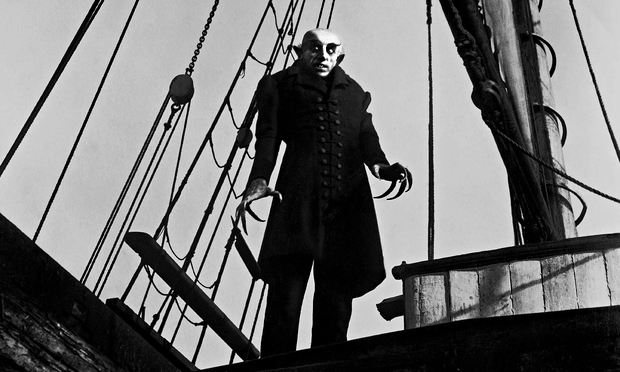Nosferatu (Murnau, 1921) Germany
Viewed by Larry Gleeson at San Luis Obispo California State Polytechnical University’s Spanos Theater as part of the 22nd Annual SLO Film Fest, formally known as San Luis Obispo International Film Festival.
 The complete 2006 digitally restored version of Nosferatu the surreal German Expressionist classic silent film by renowned director, F.W. Murnau, served as the Opening Night film for the 22nd SLO Film Fest with a new piano soundtrack performed live by German composer and pianist, Markus Horn. Most recently, Horn has performed his musical talents to another silent German film, Metropolis, directed by Fritz Lang. Interestingly, Horn created this composition in the Spanos Theater specifically for Nosferatu . Nosferatu, is similar in a stylistic vein to the classic example of German Expressionism, the 1922 silent film, The Cabinet of Dr. Caligari, with its use of unusual, odd-looking characters, geometric mise-en-scen and its abundant use of light and shadows in its storytelling. A storied production, Nosferatu, an unauthorized adaptation of Bram Stoker’s “Dracula,” was shot in 1921 and released the following year in 1922. It is very similar to “Dracula,” retaining its core characters of Jonathan and Nina Harker and the Count while omitting some of the secondary characters. A court ruling ordered all copies of the film destroyed after Prana Film, a short-lived, silent-era German film studio was unable to get the rights to the novel, was sued Bram Stoker’s widow and eventually declared bankrupted in defending itself from copyright infringement. A few copies of the film survived as the studio undauntedly had gone forward with the production changing names and details from the original novel. For example, Count Dracula became Count Orlok, played brilliantly by Max Schreck (Schreck in German translates to terror, fitting for the roles Max Schreck undertook throughout his acting career) and the term vampire became nosferatu. In addition, Count Orlok doesn’t create new vampires. Instead he killed his victims with the town folk blaming the deaths on a black plague. And, while Count Dracula was weakened by sunlight, Orlock sleeps by day as any exposure to sunlight would cause his death. In the end, Count Orlok meets his demise in drinking the blood of a young maiden, Mina, who sacrifices herself by allowing Orlok’s copulation while enticing him to do so into the day’s sunrise culminating in Orlok’s death.
The complete 2006 digitally restored version of Nosferatu the surreal German Expressionist classic silent film by renowned director, F.W. Murnau, served as the Opening Night film for the 22nd SLO Film Fest with a new piano soundtrack performed live by German composer and pianist, Markus Horn. Most recently, Horn has performed his musical talents to another silent German film, Metropolis, directed by Fritz Lang. Interestingly, Horn created this composition in the Spanos Theater specifically for Nosferatu . Nosferatu, is similar in a stylistic vein to the classic example of German Expressionism, the 1922 silent film, The Cabinet of Dr. Caligari, with its use of unusual, odd-looking characters, geometric mise-en-scen and its abundant use of light and shadows in its storytelling. A storied production, Nosferatu, an unauthorized adaptation of Bram Stoker’s “Dracula,” was shot in 1921 and released the following year in 1922. It is very similar to “Dracula,” retaining its core characters of Jonathan and Nina Harker and the Count while omitting some of the secondary characters. A court ruling ordered all copies of the film destroyed after Prana Film, a short-lived, silent-era German film studio was unable to get the rights to the novel, was sued Bram Stoker’s widow and eventually declared bankrupted in defending itself from copyright infringement. A few copies of the film survived as the studio undauntedly had gone forward with the production changing names and details from the original novel. For example, Count Dracula became Count Orlok, played brilliantly by Max Schreck (Schreck in German translates to terror, fitting for the roles Max Schreck undertook throughout his acting career) and the term vampire became nosferatu. In addition, Count Orlok doesn’t create new vampires. Instead he killed his victims with the town folk blaming the deaths on a black plague. And, while Count Dracula was weakened by sunlight, Orlock sleeps by day as any exposure to sunlight would cause his death. In the end, Count Orlok meets his demise in drinking the blood of a young maiden, Mina, who sacrifices herself by allowing Orlok’s copulation while enticing him to do so into the day’s sunrise culminating in Orlok’s death.
Murnau prided himself on utilizing various angles in his productions and Nosferatu’s cinematographer, Fritz Arno Wagner, delivers. Several shots capture the eye including a film ending low angle shot of a castle in ruin representing the demise of Count Orlok. In addition, several shots on board the ship of stacked wooden coffins and the frenzied scrambling of ship rats as a coffin is opened and its contents spilled become etched in memory. All this withstanding, the evening belonged to Markus Horn, as he mesmerized the audience with a soundtrack that brilliantly matched the photographic score in creating a dream like atmosphere for the minimalized intertitled narrative. Horn’s intense symbiosis of film and music culminated in a rousing, standing ovation by an enraptured audience at the film’s end.
This version of Nosferatu with the Markus Horn accompaniment and a run-time of 94 minutes left the audience wanting more. Much more. An exceptional opening film. Highly, highly recommended.
About this entry
You’re currently reading “Nosferatu (Murnau, 1921) Germany,” an entry on Student Film Reviews
- Published:
- 03.16.16 / 11am
- Category:
- Films
9 Comments
Jump to comment form | comments rss [?]